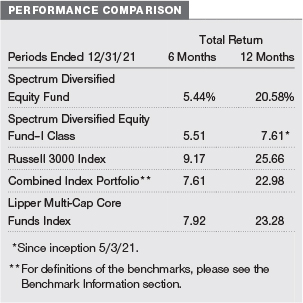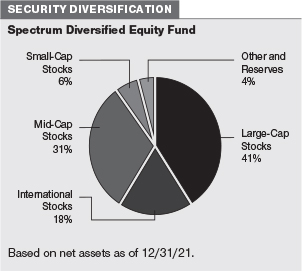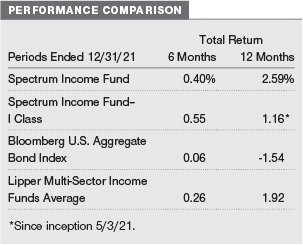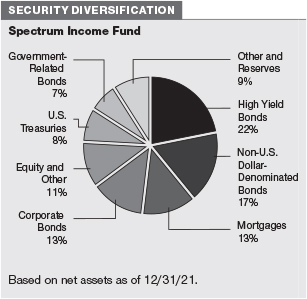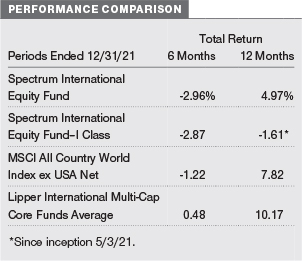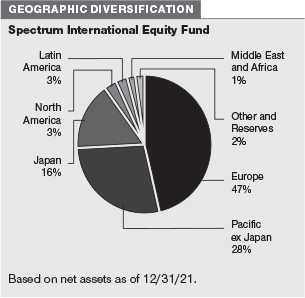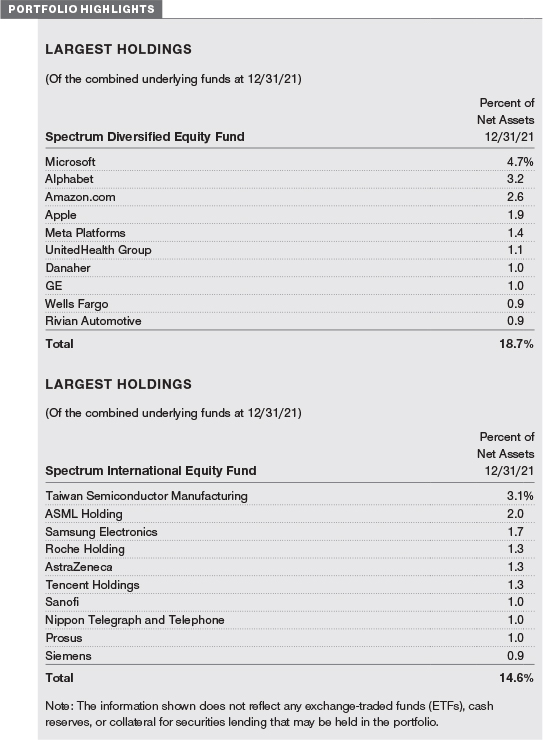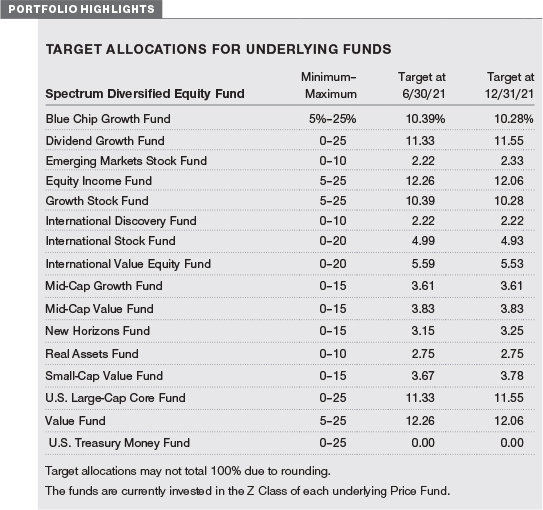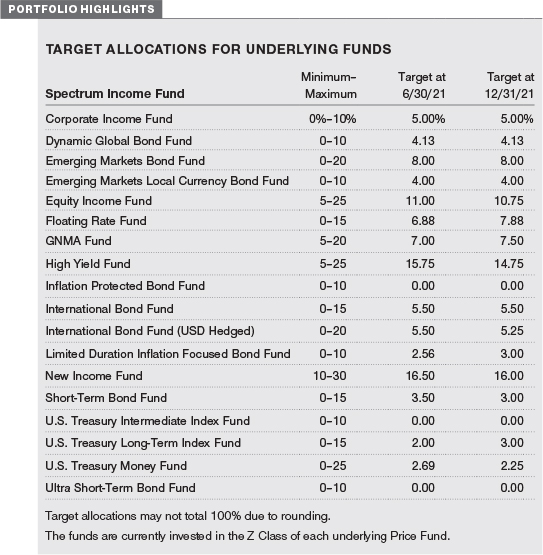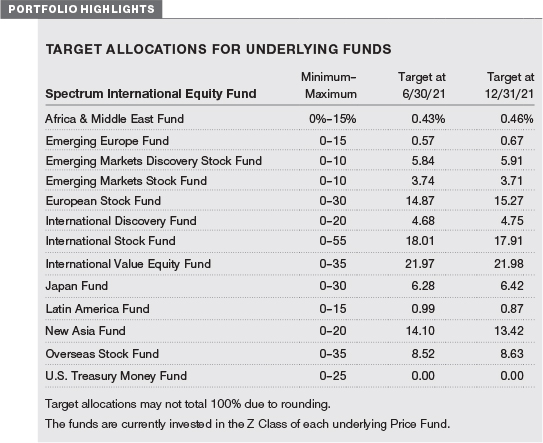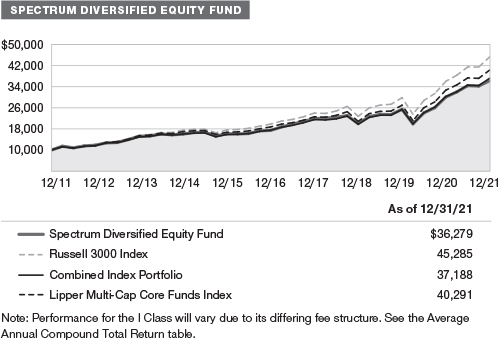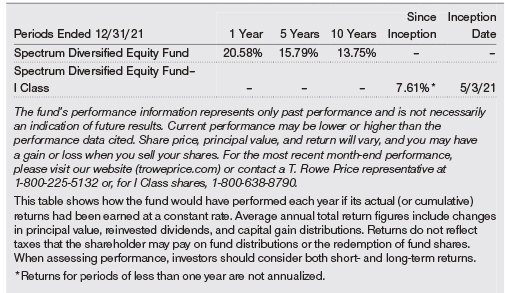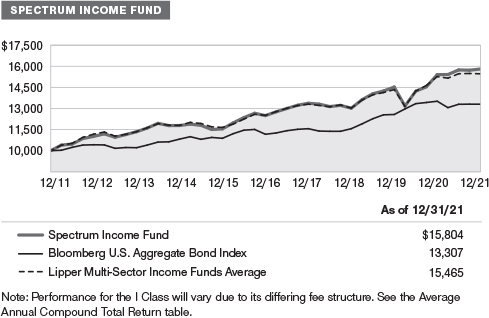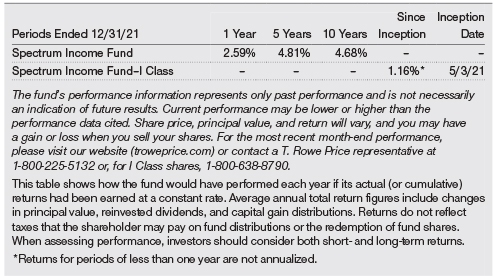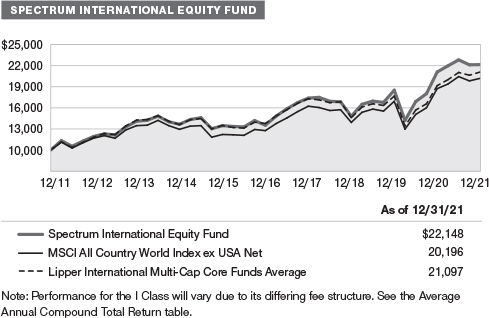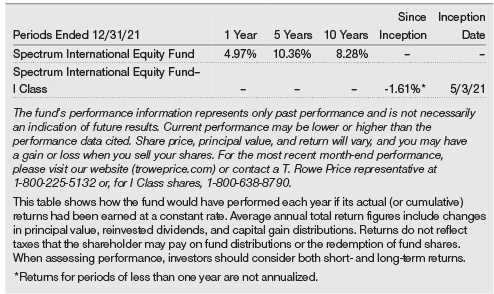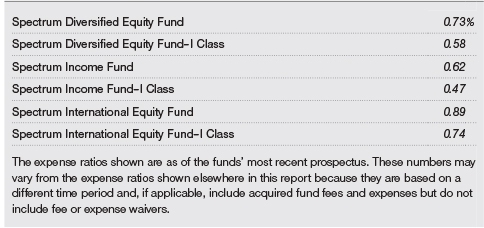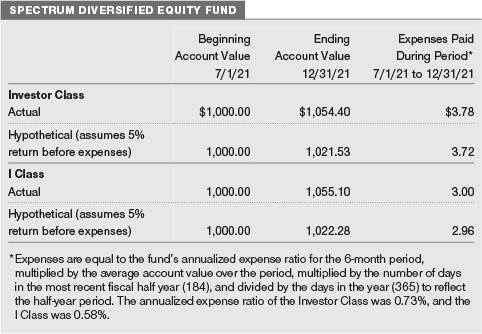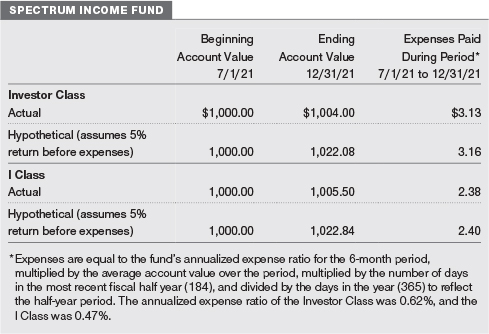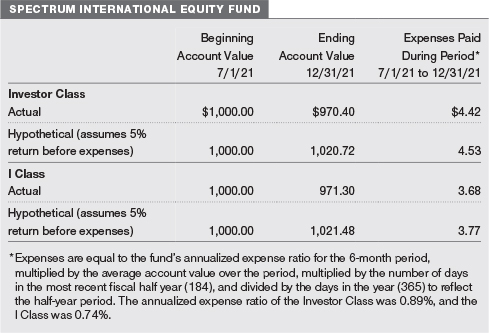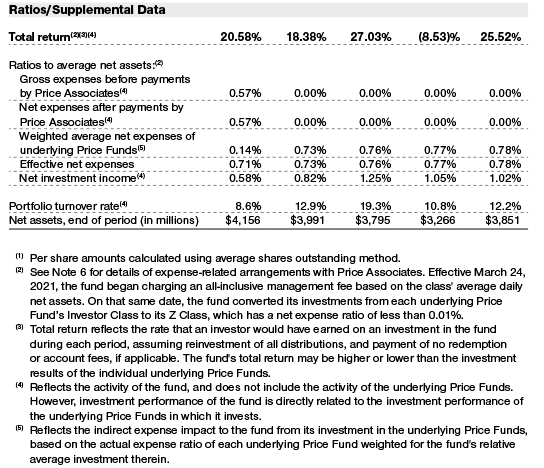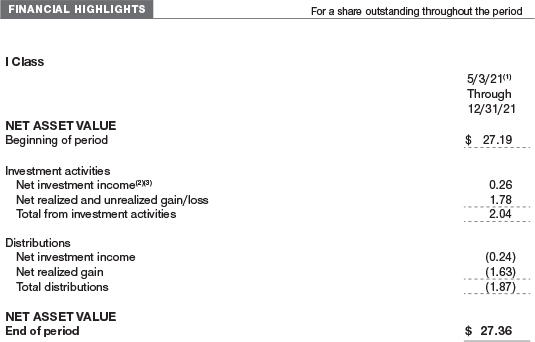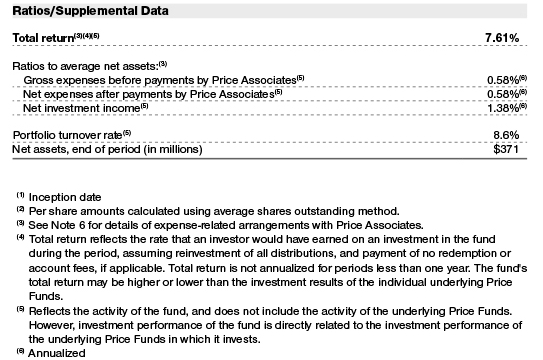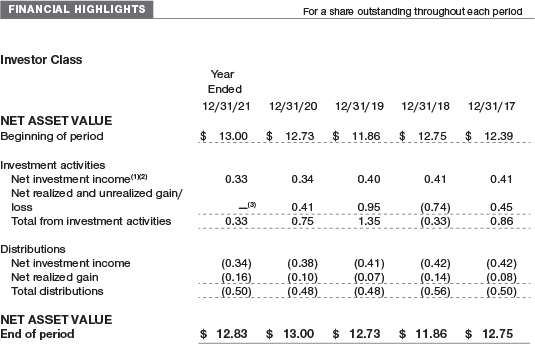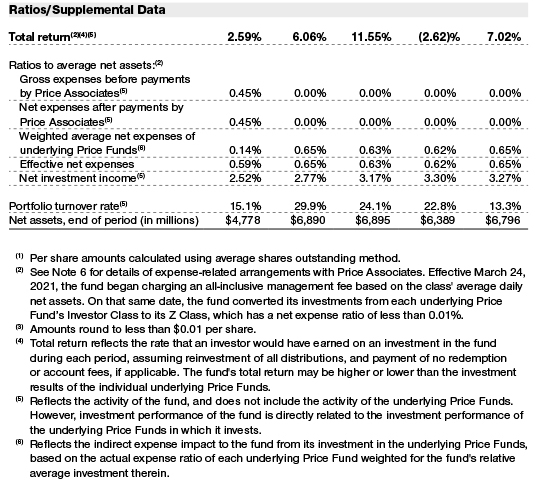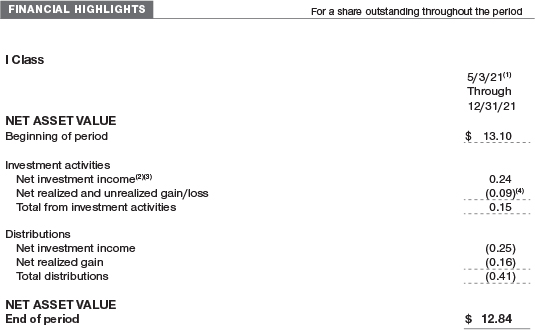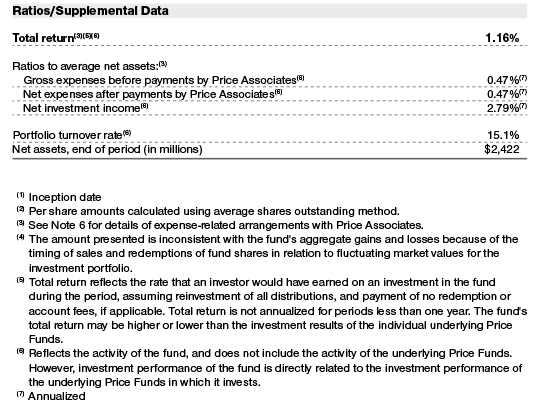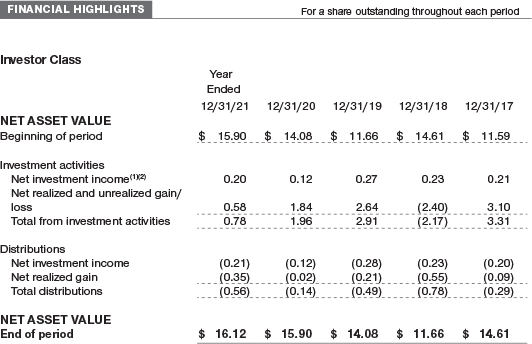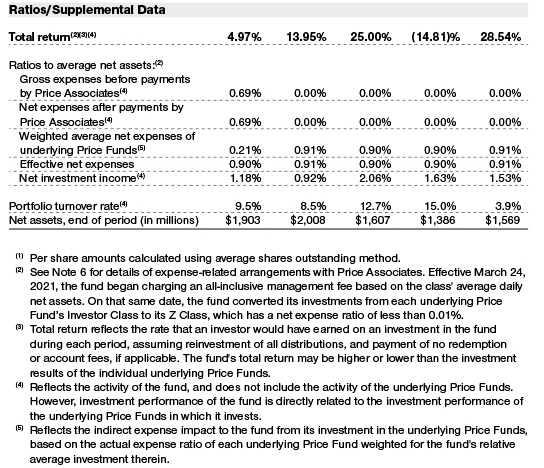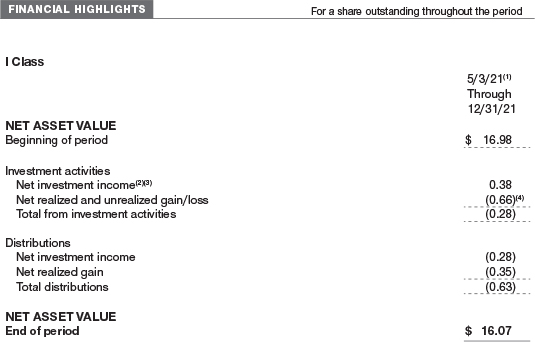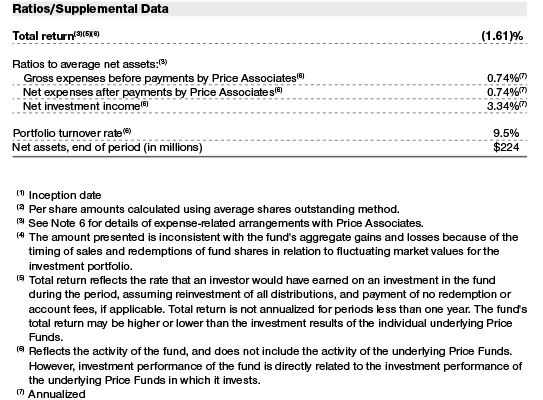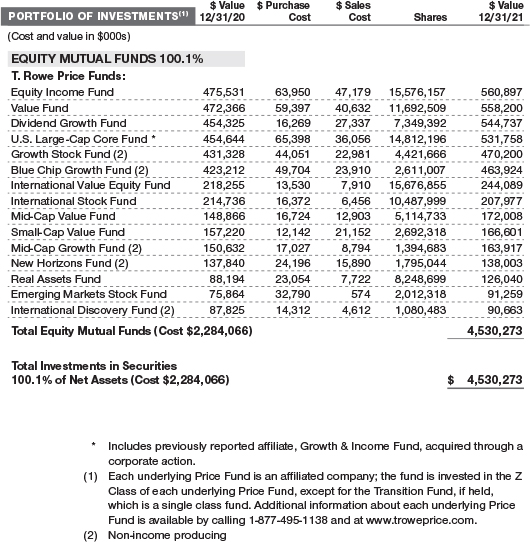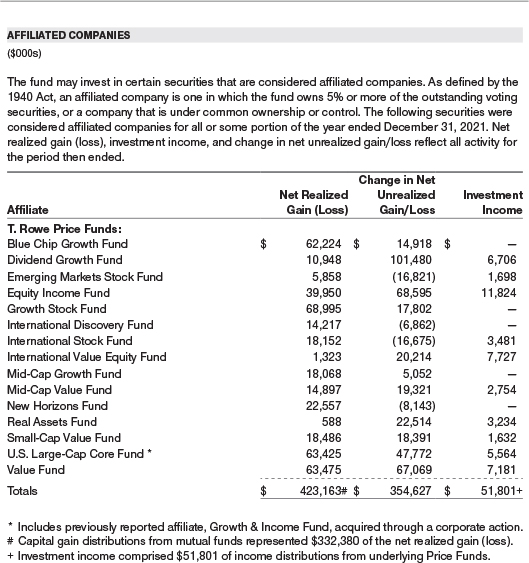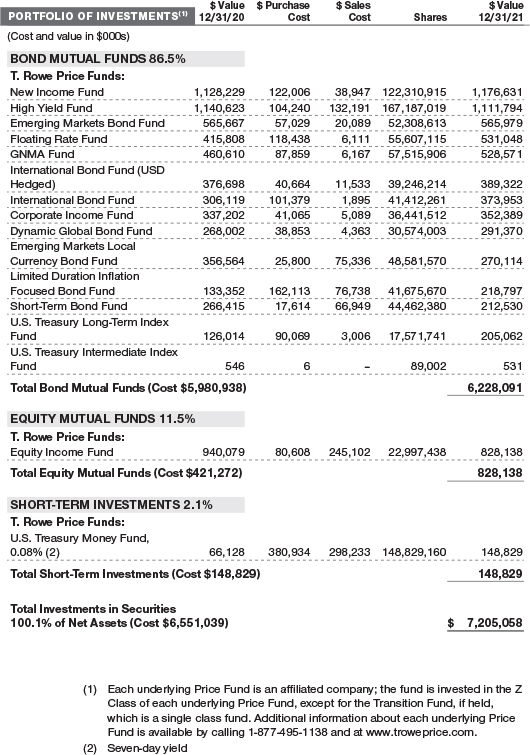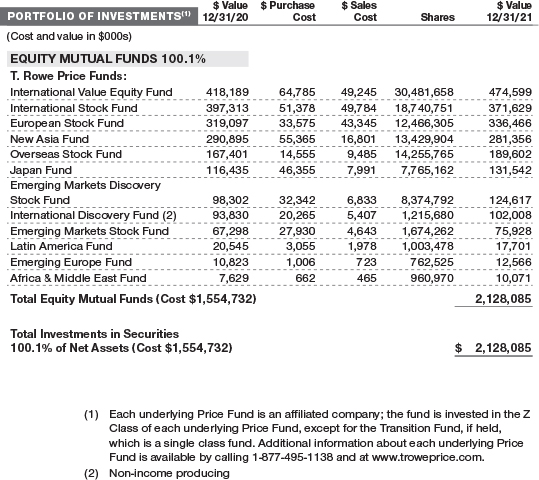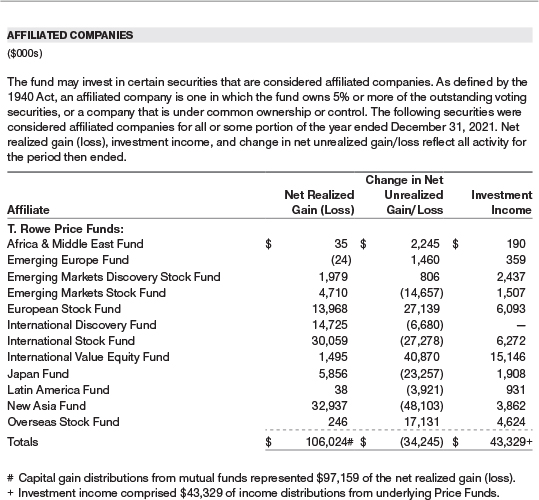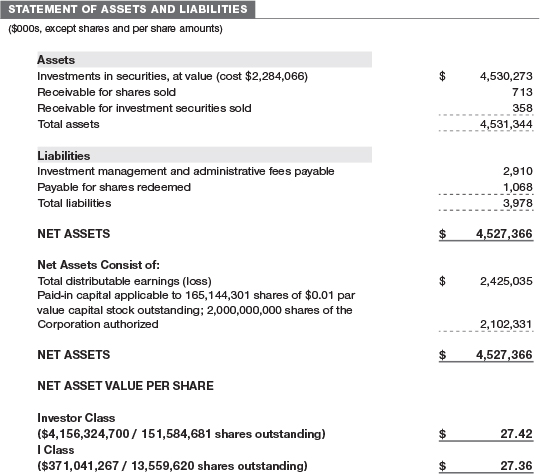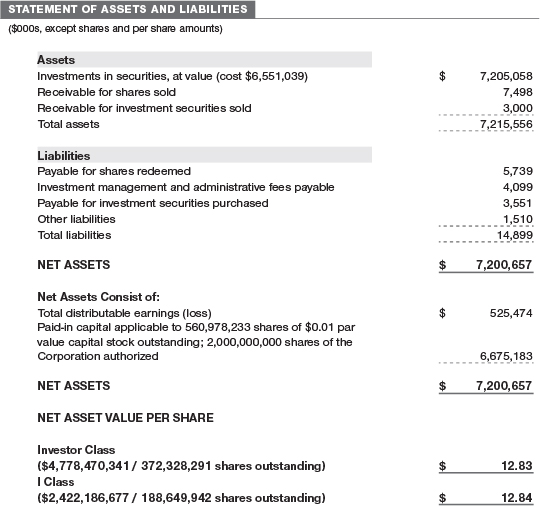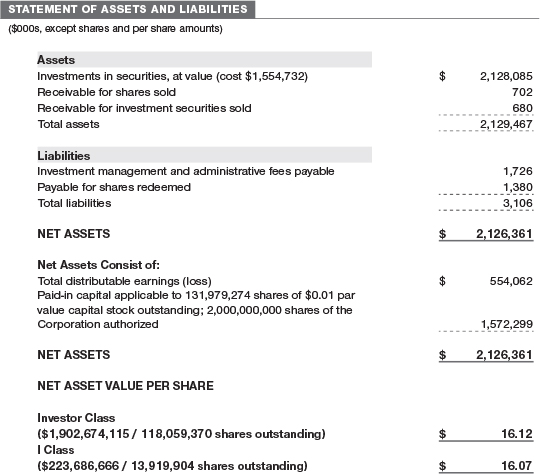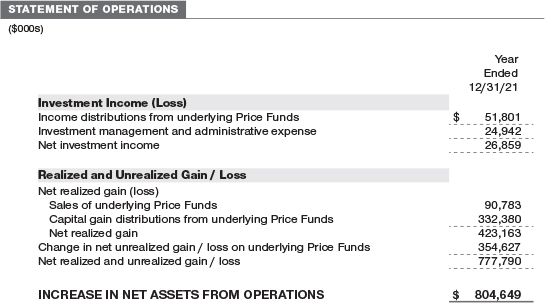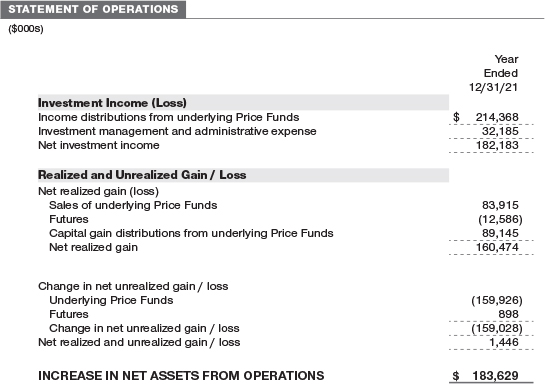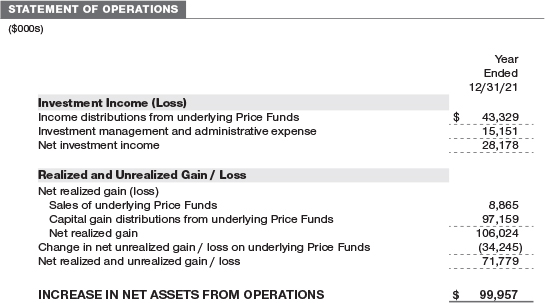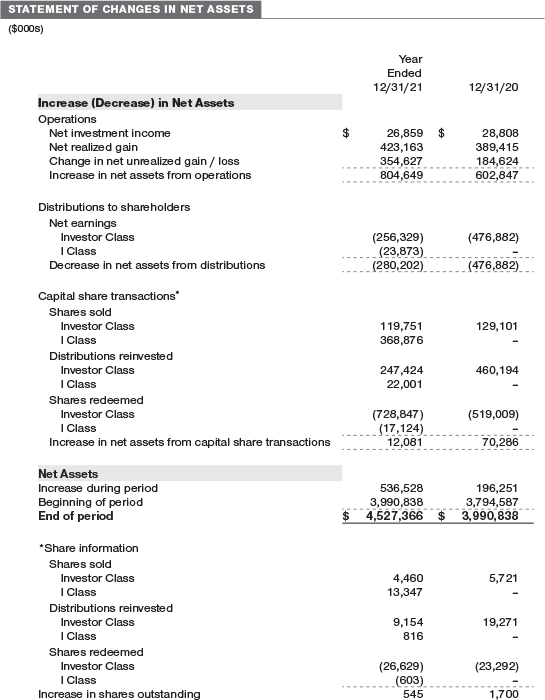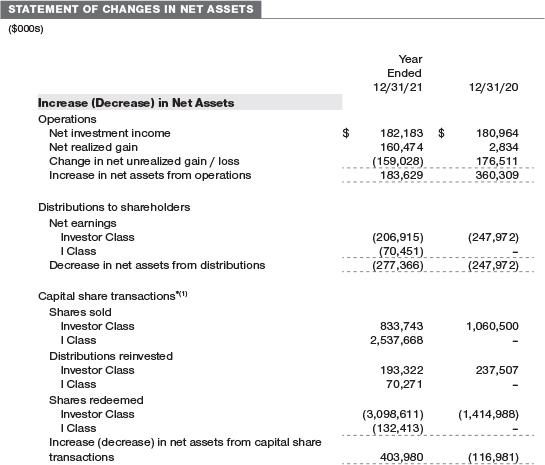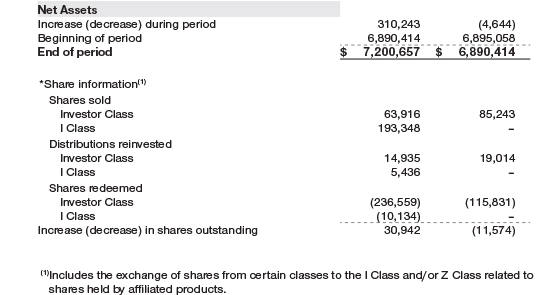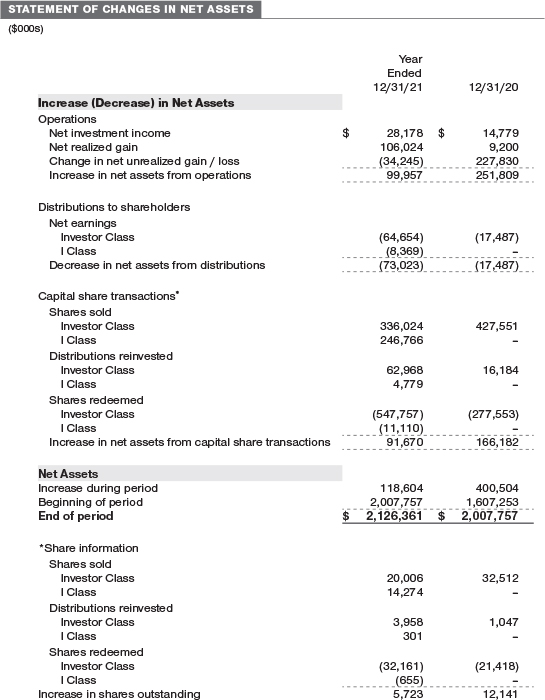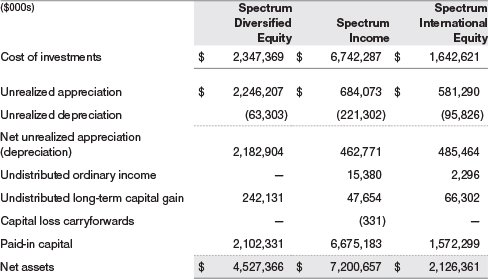UNITED STATES
SECURITIES AND EXCHANGE COMMISSION
Washington, D.C. 20549
FORM N-CSR
CERTIFIED SHAREHOLDER REPORT OF REGISTERED
MANAGEMENT INVESTMENT COMPANIES
Investment Company Act File Number: 811-04998
T. Rowe Price Spectrum Fund, Inc.
(Exact name of registrant as specified in charter)
100 East Pratt Street, Baltimore, MD 21202
(Address of principal executive offices)
David Oestreicher
100 East Pratt Street, Baltimore, MD 21202
(Name and address of agent for service)
Registrant's telephone number, including area code: (410) 345-2000
Date of fiscal year end: December 31
Date of reporting period: December 31, 2021
Item 1. Reports to Shareholders
(a) Report pursuant to Rule 30e-1.
Spectrum Funds | December 31, 2021 |
| PRSGX | Investor Class |
| TSVPX | I Class |
| RPSIX | Investor Class |
| TSPNX | I Class |
| PSILX | Investor Class |
| TSINX | I Class |
| T. ROWE PRICE SPECTRUM FUNDS |
|
HIGHLIGHTS
| ■ | During the 12-month period ended December 31, 2021, the Spectrum Income Fund meaningfully outperformed its benchmark, while the Spectrum Diversified Equity Fund and Spectrum International Equity Fund both lagged their benchmarks. Performance relative to their respective Lipper peer benchmarks was mixed. |
| |
| ■ | Exposure to diversifying sectors drove relative outperformance in the Spectrum Income Fund, while stock selection in the Spectrum Diversified Equity Fund and Spectrum International Equity Fund was a source of weakness. |
| |
| ■ | We are overweight value stocks globally as they may benefit if the path to recovery continues. We favor shorter-duration and higher-yielding fixed income sectors with supportive credit fundamentals that are likely to perform better against a backdrop of rising interest rates and higher inflation. |
| |
| ■ | Given the uncertain impact of positive and negative forces driving global financial markets, we believe that the Spectrum Funds’ broad diversification and the strength of T. Rowe Price’s fundamental research platform should benefit our investors over time across a range of market and economic environments. |
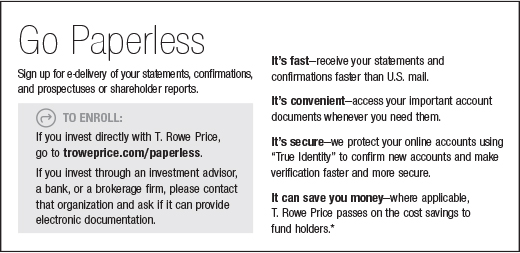
Log in to your account at troweprice.com for more information.
* Certain mutual fund accounts that are assessed an annual account service fee can also save money by switching to e-delivery.
Market Commentary
Dear Shareholder
Major stock and bond indexes produced mixed results during 2021 as strong corporate earnings growth and a recovering economy contended with worries about inflation, new coronavirus variants, and less accommodative central banks. Most developed market stock benchmarks finished the year with positive returns, although gains slowed in the second half of the year, while fixed income returns faced headwinds from rising interest rates.
Large-cap U.S. growth stocks delivered the strongest returns, but solid results were common in many developed markets. However, emerging markets stock benchmarks struggled amid a significant equity market downturn in China.
The large-cap S&P 500 Index returned almost 29%, marking its third straight year of positive returns. Robust results were widespread across the benchmark—according to Bloomberg data, 2021 marked the first year that all of the S&P 500 sectors recorded double-digit gains. The energy sector, which was the worst performer in 2020, was the leader in 2021 amid a sharp increase in oil prices, and real estate stocks also rebounded from a down year as strong demand led to rising rents. Financial and information technology stocks also produced excellent returns and outperformed the broad market.
In the fixed income market, rising Treasury yields weighed on performance, but below investment-grade corporate bonds delivered solid results as they benefited from improving fundamentals and investor demand for higheryielding securities. (Bond prices and yields move in opposite directions.)
A robust increase in corporate earnings growth appeared to be a significant performance driver during the year. According to FactSet, overall earnings for the S&P 500 rose 89% in the second quarter of 2021 versus the year before, the fastest pace since 2009, and while third-quarter earnings slowed, they continued to beat expectations at an impressive pace. Despite the significant rally in the S&P 500 during 2021, the index’s price/earnings ratio actually fell over that period as earnings rose faster than stock prices. Although economic growth showed signs of slowing at times, data remained generally positive through the end of the period. The unemployment rate, which started the year at 6.7%, fell to 3.9% by December, and job openings reached a record high.
However, optimism surrounding strong earnings and employment gains was tempered by inflation concerns. Prices surged as the release of pent-up demand and supply chain disruptions contributed to higher inflation around the globe. In the U.S., the 6.8% increase in the consumer price index for the 12-month period ended in November was the highest level since 1982, a factor that may have contributed to a decline in consumer sentiment late in the year.
Meanwhile, central banks began to move away from the extremely accommodative policies they instituted in response to the initial wave of the coronavirus. The Federal Reserve began trimming its purchases of Treasuries and agency mortgage-backed securities in November, and policymakers indicated that they could soon start raising short-term interest rates.
How markets respond to the normalization of monetary policy is an open question. While fading stimulus might pose some challenges for investors, I believe it could contribute to a return of price sensitivity in global markets, which bodes well for selective investors focused on fundamentals.
Elevated valuations, higher inflation, and the continuing struggle to control the pandemic also pose potential challenges for financial markets in 2022. However, on the positive side, household wealth gains, pent-up consumer demand, and a potential boom in capital expenditures could sustain growth even as monetary policy turns less supportive. In this environment, our investment teams will remain focused on using fundamental research to identify companies that can add value to your portfolio over the long term.
Thank you for your continued confidence in T. Rowe Price.
Sincerely,
Robert Sharps
President and CEO
Management's Discussion of Fund Performance
SPECTRUM DIVERSIFIED EQUITY FUND
INVESTMENT OBJECTIVE
The fund seeks long-term capital appreciation and growth of income with current income a secondary objective.
FUND COMMENTARY
How did the fund perform in the past 12 months?
The Spectrum Diversified Equity Fund returned 20.58% for the 12-month period ended December 31, 2021. The fund underperformed its combined index portfolio, a custom-weighted benchmark composed of indexes that represent the asset classes in which the fund invests, as well as the Lipper Multi-Cap Core Funds Index and Russell 3000 Index. (Returns for the I Class shares will vary due to its different fee structure. Past performance cannot guarantee future results.)
What factors influenced the fund's performance?
The Spectrum Diversified Equity Fund posted strong absolute returns, but trailed its benchmark for the reporting period. Security selection detracted from relative performance, especially in our U.S. large-cap growth equity strategies. The asset class posted strong returns, but narrow leadership from a few select tech stocks accounted for more than half of the index’s rise. Our underweight allocation to these technology names, which we believe to be overvalued at their current levels, drove underperformance. The negative impact was, however, somewhat mitigated by strong selection in our U.S. large-cap value equity strategy, led by names in the communication services sector. Our U.S. small-cap growth equity strategy significantly outpaced its benchmark and also added value.
Tactical decisions detracted for the period. Small-cap and value stocks generated strong returns early in the reporting period as promising coronavirus vaccine news spurred a cyclical rally, but momentum fizzled as rising inflation and a resurgence in the pandemic raised concerns and posed challenges to the recovery. Our overweight allocations to these segments proved unfavorable. Overall, large-cap growth stocks performed better in an environment where the emergence of new coronavirus variants, inflationary pressures, and supply chain disruptions dampened the outlook for more cyclically oriented stocks.
The fund’s exposure to real assets stocks, which outperformed global equities, was a modest positive. The positive impact was, however, partly offset by an underweight allocation to the sector. Within the sector, commodities enjoyed a stellar year, benefiting from a surge in inflation, supply bottlenecks, and a robust recovery in demand as global economies gradually reopened.
How is the fund positioned?
The Spectrum Diversified Equity Fund invests in several underlying T. Rowe Price funds that focus on U.S. and international equities across the full range of market capitalizations and styles, as well as in emerging markets.
We are modestly overweight to international stocks relative to U.S. stocks. International stocks have a cyclical profile and could benefit as supply chain bottlenecks ease and the economic recovery continues. Elevated U.S. stock valuations reflect a strong recovery supported by healthy consumer spending and strong earnings growth; however, Fed tightening, waning fiscal stimulus, and slowing growth present headwinds. Outside the U.S., we are overweight to emerging markets relative to developed markets. In addition to attractive valuations, Chinese regulatory pressures may have peaked, global trade is likely to pick up as supply chain concerns ease, and vaccination levels continue to improve. However, uncertainty around the pandemic may delay progress in emerging markets.
In the U.S., we remain overweight to value-oriented equities. Value stocks are exposed to cyclical trends that could benefit from the release of pent-up consumer demand, elevated savings, potential increases in capital expenditures, and greater spending on infrastructure projects. We believe higher interest rates—which are typically a headwind for growth stocks—could also be supportive for value stocks, given their heavy exposure to financials. We are overweight to U.S. small-caps relative to larger companies. Although elevated input costs and wage pressures could weigh on margins, small-cap stocks have attractive valuations and should be boosted by economic growth and infrastructure spending.
Among international equities, we are overweight value stocks relative to growth. The cyclical orientation of international value stocks combined with attractive relative valuations and a supportive earnings outlook could be catalysts for outperformance.
We are underweight to real assets equities. The long-term outlook for commodities remains challenged given demand and supply imbalances driven by structural oversupply and fading industrial demand from China. While the real estate sector remains attractive in the context of the economic recovery, rising interest rates could be problematic.
SPECTRUM INCOME FUND
INVESTMENT OBJECTIVE
The fund seeks a high level of current income with moderate share price fluctuation.
FUND COMMENTARY
How did the fund perform in the past 12 months?
The Spectrum Income Fund returned 2.59% for the 12-month period ended December 31, 2021. The fund outperformed both the Bloomberg U.S. Aggregate Bond Index and its peer Lipper Multi-Sector Income Funds Average benchmark. (Returns for the I Class shares will vary due to its different fee structure. Past performance cannot guarantee future results.)
What factors influenced the fund’s performance?
The Spectrum Income Fund significantly outperformed its benchmark for the year. Exposure to sectors and asset classes that are not included in the fund’s benchmark drove outperformance. Most notably, dividend-paying equities posted double-digit gains and strongly outpaced investment-grade bonds. Upward pressure on interest rates presented a challenging environment for the fixed income sector but was supportive for dividend-paying equities. Positive security selection within this strategy also boosted results, led by holdings in the financials and information technology sectors.
Overall, fixed income diversifiers also added value. High yield bonds and floating rate bank loans—which were supported by favorable corporate earnings and their lower sensitivity to rising interest rates—meaningfully outperformed investment-grade bonds. Conversely, the inclusion of unhedged nondollar bonds and emerging markets local currency debt weighed on relative returns as a stronger dollar, boosted by a robust post-pandemic recovery relative to other regions, negated gains for U.S. investors. Overweight allocations to these segments were also a source of weakness.
Security selection in our investment-grade bond strategy, which outpaced the Bloomberg U.S. Aggregate Bond Index, added value. The strategy’s out-of-benchmark allocations to high yield bonds and bank loans were positive contributors to performance and benefited from their yield advantage in a supportive credit environment with very low default rates. Investment-grade corporate names associated with the economic reopening theme—including energy, transportation, and real estate issuers—also helped returns.
How is the fund positioned?
The Spectrum Income Fund invests primarily in fixed income securities through a diversified mix of U.S. and international T. Rowe Price mutual funds. Underlying investments also include a fund focused on dividend-paying U.S. large-cap stocks.
For U.S. investment-grade bonds, longer-term interest rates continue to be biased higher due to elevated inflation levels, while short-term rates rise in response to expectations for Fed tightening. Corporate fundamentals and demand for yield are supportive for credit, but upside is limited given valuations.
We remain overweight below investment-grade bonds, but over the period, we shifted our emphasis from high yield bonds to floating rate loans. We moderated our overweight to high yield bonds. While their yields are still relatively attractive compared with investment-grade debt and strong fundamentals and low default risk are supportive, much of the positive backdrop is reflected in current tight credit spreads—the difference in yield between bonds of a similar maturity but with different credit quality—limiting their potential upside. We are overweight to floating rate bank loans, given increasing expectations of higher interest rates and the potential for more persistent inflation. Credit fundamentals for floating rate bank loans remain strong, and demand for yield should provide additional tailwinds. However, the quality of newly issued floating rate bank loans warrants caution.
We moderated our overweight to hedged nondollar bonds. The hedged yield advantage has moderated substantially, as the Fed appears more hawkish while the European Central Bank and Bank of Japan maintain an accommodative policy. Short-term rates are expected to trend higher with major central bank tightening, while long-term rates are reacting to lingering inflation pressures and renewed concerns about growth and policy missteps. We are overweight to unhedged nondollar bonds as the sector provides potential yield curve diversification, particularly given the differing pace at which various central banks are progressing with monetary policy tightening. The sector also offers opportunities in select credit markets.
We are neutral emerging markets U.S. dollar-denominated bonds compared with developed markets. While the sector offers attractive yields and attractive valuations, we believe the sector is fairly priced as it could face risks due to Fed tightening, coronavirus concerns, and policy-related uncertainty in China. We are overweight to emerging markets local currency bonds. Valuations remain modestly attractive with currencies cheap relative to the U.S. dollar, and we expect the sector to benefit from peaking inflation and fewer rate hikes over the intermediate term.
We pared our underweight to long-term U.S. Treasury bonds. As the Fed moves to raise rates and long-run inflation expectations moderate, this should help anchor yields on longer-maturity bonds. Additionally, we believe that the long end is the primary portion of the curve that could rally in a potential risk-off environment. While we do not see significant negative shocks as likely, a modest allocation to long-term Treasuries offers ballast should significant volatility return to equity markets.
We are modestly underweight to dividend-paying equities. Although the potential release of pent-up demand and elevated savings could be supportive, elevated equity valuations amid decelerating economic growth, potential tightening by central banks, and renewed pandemic uncertainty create a more challenging environment. While bonds remain susceptible to interest rate increases and elevated inflation, credit sector fundamentals are supportive.
SPECTRUM INTERNATIONAL EQUITY FUND
INVESTMENT OBJECTIVE
The fund seeks long-term capital appreciation.
FUND COMMENTARY
How did the fund perform in the past 12 months?
The Spectrum International Equity Fund returned 4.97% for the 12-month period ended December 31, 2021. The fund underperformed the MSCI All Country World Index ex USA Net, as well as its peer Lipper International Multi-Cap Core Funds Average benchmark. (Returns for the I Class shares will vary due to its different fee structure. Past performance cannot guarantee future results.)
What factors influenced the fund’s performance?
During the reporting period, the Spectrum International Equity Fund lagged its benchmark. Differences in the regional profile of the portfolio versus the benchmark, particularly an underweight to outperforming Canadian equities, hurt relative performance.
Within the underlying strategies, the Japan Fund was a notable detractor for the period. A cyclical rally in the Japanese equity market benefited value stocks but was a considerable headwind. Our fund’s bias toward higher-quality, secular growth companies—which helped deliver stellar results over the course of 2020—weighed on relative results during the reporting period. Within the fund, holdings in the consumer discretionary and information technology sectors were a source of weakness. We believe that the rotation from growth to value stocks in Japan has been far too extreme, and we expect markets to refocus on fundamentals and on companies that can durably grow earnings in a more normalized market environment. The International Stock Fund and Emerging Markets Stock Fund also trailed their benchmarks and hurt results, weighed down by names in the industrial business and services and financials sectors, respectively.
Conversely, strong security selection in the International Value Equity Fund contributed to relative performance. The New Asia Fund and Overseas Stock Fund also outpaced their benchmarks and boosted relative results. Overall, names in the banking, insurance, and semiconductors and semiconductor equipment industries drove outperformance. On a regional basis, holdings in developed Pacific Asia ex Japan were among the best performers.
How is the fund positioned?
The Spectrum International Equity Fund offers investors broadly diversified exposure to international equities in developed and emerging markets.
We are overweight to emerging markets relative to developed markets. In addition to attractive valuations, Chinese regulatory pressures may have peaked, global trade is likely to pick up as supply chain concerns ease, and vaccination levels continue to improve. However, uncertainty around the pandemic may delay progress in emerging markets.
Among developed markets, we are overweight to Japanese equities, which we believe are attractively valued. Although potential virus mutations are a headwind for the region, fiscal and monetary stimulus continue to provide a solid backdrop for the nation’s economic recovery. In our view, tentative moves toward economic reopening and supportive political developments should be beneficial for Japanese stocks. In addition, improving corporate governance and focus on shareholder-oriented reforms could provide a catalyst to value realization over the longer term.
We are underweight to European equities. Economies in the region are being weighed down by the spread of the new coronavirus variant, elevated energy prices, and supply chain issues. Although the accommodative actions from the European Central Bank have been supportive, the European Union and other regional central banks have taken steps toward tightening monetary policy. We believe that more cyclically oriented European equities are well positioned to benefit from a global recovery as the effects of the pandemic fade; however, longer-term catalysts for the broader region are scarce, and fading Chinese growth is a headwind.
We remain overweight to value stocks relative to growth stocks. The deep cyclical orientation of international value stocks combined with attractive relative valuations and a supportive earnings outlook could be catalysts for outperformance.
What is portfolio management’s outlook?
The past year was characterized by elevated volatility, as persistent inflationary pressures and the emergence of new highly infectious coronavirus variants threatened the economic recovery. Supply chain disruptions, a notable headwind in 2021, showed signs of easing early in the fourth quarter, but a resurgence in the pandemic late in the year due to the omicron variant threatens to exacerbate these issues. Further, global monetary policy is broadly on the path toward tightening—albeit in an unsynchronized fashion and over an extended period—while new U.S. fiscal spending is expected to fall short of prior expectations. Although these challenges may slow economic growth, we do not believe that the recovery will be derailed.
With this backdrop, we expect global economic growth to moderate from current levels but remain above trend. Equity markets are vulnerable to a pullback from extended valuations, particularly as the fading tailwinds from monetary and fiscal stimulus contribute to slower earnings growth. Other key risks to global markets include potential central bank missteps, slowing growth in China, energy shortages, and increasing geopolitical concerns. In our view, these conditions contribute to a less compelling risk/reward trade-off between stocks and bonds in the near term, and we believe that a more modest allocation to equities may be prudent.
The elevated levels of volatility and uncertainty in global markets underscore the value of our thoughtful strategic investing approach. Given the uncertain impact of positive and negative forces driving global financial markets, we believe that the Spectrum Funds’ broad diversification and the strength of T. Rowe Price’s fundamental research platform should benefit our investors over time across a range of market and economic environments.
The views expressed reflect the opinions of T. Rowe Price as of the date of this report and are subject to change based on changes in market, economic, or other conditions. These views are not intended to be a forecast of future events and are no guarantee of future results.
RISKS OF INVESTING
As with all stock and bond mutual funds, each fund’s share price can fall because of weakness in the stock or bond markets, a particular industry, or specific holdings. Stock markets can decline for many reasons, including adverse political or economic developments, changes in investor psychology, or heavy institutional selling. The prospects for an industry or company may deteriorate because of a variety of factors, including disappointing earnings or changes in the competitive environment. In addition, the investment manager’s assessment of companies held in a fund may prove incorrect, resulting in losses or poor performance even in rising markets.
Bonds are subject to interest rate risk, the decline in bond prices that usually accompanies a rise in interest rates, and credit risk, the chance that any fund holding could have its credit rating downgraded or that a bond issuer will default (fail to make timely payments of interest or principal), potentially reducing the fund’s income level and share price. High yield corporate bonds could have greater price declines than funds that invest primarily in high-quality bonds. Companies issuing high yield bonds are not as strong financially as those with higher credit ratings, so the bonds are usually considered speculative investments.
Funds that invest overseas may carry more risk than funds that invest strictly in U.S. assets. Risks can result from varying stages of economic and political development; differing regulatory environments, trading days, and accounting standards; and higher transaction costs of non-U.S. markets. Non-U.S. investments are also subject to currency risk, or a decline in the value of a foreign currency versus the U.S. dollar, which reduces the dollar value of securities denominated in that currency.
For a thorough discussion of risks, please see each fund’s prospectus.
BENCHMARK INFORMATION
Combined index portfolio: An unmanaged blended index portfolio created as a custom benchmark for the Spectrum Diversified Equity Fund consisting of 70% Russell 3000 Index and 30% MSCI All Country World ex-USA IMI.
Note: Bloomberg® and Bloomberg U.S. Aggregate Bond Index are service marks of Bloomberg Finance L.P. and its affiliates, including Bloomberg Index Services Limited (“BISL”), the administrator of the index (collectively, “Bloomberg”) and have been licensed for use for certain purposes by T. Rowe Price. Bloomberg is not affiliated with T. Rowe Price, and Bloomberg does not approve, endorse, review, or recommend its products. Bloomberg does not guarantee the timeliness, accurateness, or completeness of any data or information relating to its products.
Note: Lipper, a Thomson Reuters Company, is the source for all Lipper content reflected in these materials. Copyright 2022 © Refinitiv. All rights reserved. Any copying, republication or redistribution of Lipper content is expressly prohibited without the prior written consent of Lipper. Lipper shall not be liable for any errors or delays in the content, or for any actions taken in reliance thereon.
Note: MSCI makes no express or implied warranties or representations and shall have no liability whatsoever with respect to any MSCI data contained herein. The MSCI data may not be further redistributed or used as a basis for other indices or any securities or financial products. This report is not approved, reviewed, or produced by MSCI.
Note: London Stock Exchange Group plc and its group undertakings (collectively, the “LSE Group”). © LSE Group 2022. All rights in the FTSE Russell indexes or data vest in the relevant LSE Group company which owns the index or the data. Neither LSE Group nor its licensors accept any liability for any errors or omissions in the indexes or data and no party may rely on any indexes or data contained in this communication. No further distribution of data from the LSE Group is permitted without the relevant LSE Group company’s express written consent. The LSE Group does not promote, sponsor or endorse the content of this communication.
GROWTH OF $10,000
This chart shows the value of a hypothetical $10,000 investment in the fund over the past 10 fiscal year periods or since inception (for funds lacking 10-year records). The result is compared with benchmarks, which include a broad-based market index and may also include a peer group average or index. Market indexes do not include expenses, which are deducted from fund returns as well as mutual fund averages and indexes.
AVERAGE ANNUAL COMPOUND TOTAL RETURN
GROWTH OF $10,000
This chart shows the value of a hypothetical $10,000 investment in the fund over the past 10 fiscal year periods or since inception (for funds lacking 10-year records). The result is compared with benchmarks, which include a broad-based market index and may also include a peer group average or index. Market indexes do not include expenses, which are deducted from fund returns as well as mutual fund averages and indexes.
AVERAGE ANNUAL COMPOUND TOTAL RETURN
GROWTH OF $10,000
This chart shows the value of a hypothetical $10,000 investment in the fund over the past 10 fiscal year periods or since inception (for funds lacking 10-year records). The result is compared with benchmarks, which include a broad-based market index and may also include a peer group average or index. Market indexes do not include expenses, which are deducted from fund returns as well as mutual fund averages and indexes.
AVERAGE ANNUAL COMPOUND TOTAL RETURN
EXPENSE RATIO
FUND EXPENSE EXAMPLE
As a mutual fund shareholder, you may incur two types of costs: (1) transaction costs, such as redemption fees or sales loads, and (2) ongoing costs, including management fees, distribution and service (12b-1) fees, and other fund expenses. The following example is intended to help you understand your ongoing costs (in dollars) of investing in the fund and to compare these costs with the ongoing costs of investing in other mutual funds. The example is based on an investment of $1,000 invested at the beginning of the most recent six-month period and held for the entire period.
Please note that the fund has two share classes: The original share class (Investor Class) charges no distribution and service (12b-1) fee, and the I Class shares are also available to institutionally oriented clients and impose no 12b-1 or administrative fee payment. Each share class is presented separately in the table.
Actual Expenses
The first line of the following table (Actual) provides information about actual account values and expenses based on the fund’s actual returns. You may use the information on this line, together with your account balance, to estimate the expenses that you paid over the period. Simply divide your account value by $1,000 (for example, an $8,600 account value divided by $1,000 = 8.6), then multiply the result by the number on the first line under the heading “Expenses Paid During Period” to estimate the expenses you paid on your account during this period.
Hypothetical Example for Comparison Purposes
The information on the second line of the table (Hypothetical) is based on hypothetical account values and expenses derived from the fund’s actual expense ratio and an assumed 5% per year rate of return before expenses (not the fund’s actual return). You may compare the ongoing costs of investing in the fund with other funds by contrasting this 5% hypothetical example and the 5% hypothetical examples that appear in the shareholder reports of the other funds. The hypothetical account values and expenses may not be used to estimate the actual ending account balance or expenses you paid for the period.
Note: T. Rowe Price charges an annual account service fee of $20, generally for accounts with less than $10,000. The fee is waived for any investor whose T. Rowe Price mutual fund accounts total $50,000 or more; accounts electing to receive electronic delivery of account statements, transaction confirmations, prospectuses, and shareholder reports; or accounts of an investor who is a T. Rowe Price Personal Services or Enhanced Personal Services client (enrollment in these programs generally requires T. Rowe Price assets of at least $250,000). This fee is not included in the accompanying table. If you are subject to the fee, keep it in mind when you are estimating the ongoing expenses of investing in the fund and when comparing the expenses of this fund with other funds.
You should also be aware that the expenses shown in the table highlight only your ongoing costs and do not reflect any transaction costs, such as redemption fees or sales loads. Therefore, the second line of the table is useful in comparing ongoing costs only and will not help you determine the relative total costs of owning different funds. To the extent a fund charges transaction costs, however, the total cost of owning that fund is higher.
| T. ROWE PRICE SPECTRUM DIVERSIFIED EQUITY FUND |
|
The accompanying notes are an integral part of these financial statements.
The accompanying notes are an integral part of these financial statements.
| T. ROWE PRICE SPECTRUM INCOME FUND |
|
The accompanying notes are an integral part of these financial statements.
The accompanying notes are an integral part of these financial statements.
| T. ROWE PRICE SPECTRUM INTERNATIONAL EQUITY FUND |
|
The accompanying notes are an integral part of these financial statements.
The accompanying notes are an integral part of these financial statements.
| T. ROWE PRICE SPECTRUM DIVERSIFIED EQUITY FUND |
|
December 31, 2021
The accompanying notes are an integral part of these financial statements.
| T. ROWE PRICE SPECTRUM INCOME FUND |
|
December 31, 2021
The accompanying notes are an integral part of these financial statements.
| T. ROWE PRICE SPECTRUM INTERNATIONAL EQUITY FUND |
|
December 31, 2021
The accompanying notes are an integral part of these financial statements.
| T. ROWE PRICE SPECTRUM DIVERSIFIED EQUITY FUND |
|
December 31, 2021
The accompanying notes are an integral part of these financial statements.
| T. ROWE PRICE SPECTRUM INCOME FUND |
|
December 31, 2021
The accompanying notes are an integral part of these financial statements.
| T. ROWE PRICE SPECTRUM INTERNATIONAL EQUITY FUND |
|
December 31, 2021
The accompanying notes are an integral part of these financial statements.
| T. ROWE PRICE SPECTRUM DIVERSIFIED EQUITY FUND |
|
The accompanying notes are an integral part of these financial statements.
| T. ROWE PRICE SPECTRUM INCOME FUND |
|
The accompanying notes are an integral part of these financial statements.
| T. ROWE PRICE SPECTRUM INTERNATIONAL EQUITY FUND |
|
The accompanying notes are an integral part of these financial statements.
| T. ROWE PRICE SPECTRUM DIVERSIFIED EQUITY FUND |
|
The accompanying notes are an integral part of these financial statements.
| T. ROWE PRICE SPECTRUM INCOME FUND |
|
The accompanying notes are an integral part of these financial statements.
| T. ROWE PRICE SPECTRUM INTER NATIONAL EQUITY FUND |
|
The accompanying notes are an integral part of these financial statements.
| NOTES TO FINANCIAL STATEMENTS |
T. Rowe Price Spectrum Fund, Inc. (the corporation) is registered under the Investment Company Act of 1940 (the 1940 Act). Spectrum Diversified Equity Fund, Spectrum Income Fund, and Spectrum International Equity Fund (collectively, the Spectrum Funds) are diversified open-end management investment companies established by the corporation. Each Spectrum Fund broadly diversifies its assets within specified ranges among a set of T. Rowe Price mutual funds (underlying Price Funds) representing specific market segments. Spectrum Diversified Equity seeks long-term capital appreciation and growth of income with current income as a secondary objective. Spectrum Income seeks a high level of current income with moderate share price fluctuation. Spectrum International Equity seeks long-term capital appreciation.
Each fund has two classes of shares as follows: Spectrum Diversified Equity Fund (Investor Class) and Spectrum Diversified Equity Fund – I Class (I Class); Spectrum Income Fund (Investor Class) and Spectrum Income Fund – I Class (I Class); and Spectrum International Equity Fund (Investor Class) and Spectrum International Equity Fund – I Class (I Class). I Class shares require a $500,000 initial investment minimum, although the minimum generally is waived or reduced for financial intermediaries, eligible retirement plans and certain other accounts. Prior to November 15, 2021, the initial investment minimum was $1 million and was generally waived for financial intermediaries, eligible retirement plans, and other certain accounts. Each class has exclusive voting rights on matters related solely to that class; separate voting rights on matters that relate to both classes; and, in all other respects, the same rights and obligations as the other class.
NOTE 1 - SIGNIFICANT ACCOUNTING POLICIES
Basis of Preparation Each fund is an investment company and follows accounting and reporting guidance in the Financial Accounting Standards Board Accounting Standards Codification Topic 946 (ASC 946). The accompanying financial statements were prepared in accordance with accounting principles generally accepted in the United States of America (GAAP), including, but not limited to, ASC 946. GAAP requires the use of estimates made by management. Management believes that estimates and valuations of the underlying Price Funds are appropriate; however, actual results may differ from those estimates, and the valuations reflected in the accompanying financial statements may differ from the value ultimately realized upon sale of the underlying Price Funds.
Investment Transactions, Investment Income, and Distributions Investment transactions are accounted for on the trade date basis. Income and expenses are recorded on the accrual basis. Realized gains and losses are reported on the identified cost basis. Income tax-related interest and penalties, if incurred, are recorded as income tax expense. Dividends received from underlying Price Fund investments are reflected as dividend income; capital gain distributions are reflected as realized gain/loss. Income and capital gain distributions from the underlying Price Funds are recorded on the ex-dividend date. Distributions to shareholders are recorded on the ex-dividend date. Income distributions are declared by Spectrum Income daily and paid monthly. Income distributions, if any, are declared and paid by Spectrum Diversified Equity and Spectrum International Equity annually. A capital gain distribution may also be declared and paid by each fund annually.
Class Accounting Investment management and administrative expenses incurred by each class are charged directly to the class to which they relate. Expenses common to all classes, income distributions from the underlying Price Funds, and realized and unrealized gains and losses are allocated to the classes based upon the relative daily net assets of each class.
Capital Transactions Each investor’s interest in the net assets of each fund is represented by fund shares. Each fund’s net asset value (NAV) per share is computed at the close of the New York Stock Exchange (NYSE), normally 4 p.m. ET, each day the NYSE is open for business. However, the NAV per share may be calculated at a time other than the normal close of the NYSE if trading on the NYSE is restricted, if the NYSE closes earlier, or as may be permitted by the SEC. Purchases and redemptions of fund shares are transacted at the next-computed NAV per share, after receipt of the transaction order by T. Rowe Price Associates, Inc., or its agents.
Indemnification In the normal course of business, the funds may provide indemnification in connection with its officers and directors, service providers, and/or private company investments. Each fund’s maximum exposure under these arrangements is unknown; however, the risk of material loss is currently considered to be remote.
NOTE 2 - VALUATION
Each fund’s financial instruments are valued at the close of the NYSE and are reported at fair value, which GAAP defines as the price that would be received to sell an asset or paid to transfer a liability in an orderly transaction between market participants at the measurement date. Investments in the underlying Price Funds are valued at their closing NAV per share on the day of valuation. Assets and liabilities other than financial instruments, including short-term receivables and payables, are carried at cost, or estimated realizable value, if less, which approximates fair value.
The T. Rowe Price Valuation Committee (the Valuation Committee) is an internal committee that has been delegated certain responsibilities by the funds' Board of Directors (the Board) to ensure that financial instruments are appropriately priced at fair value in accordance with GAAP and the 1940 Act. Subject to oversight by the Board, the Valuation Committee develops and oversees pricing-related policies and procedures and approves all fair value determinations. Specifically, the Valuation Committee establishes policies and procedures used in valuing financial instruments; determines pricing techniques, sources, and persons eligible to effect fair value pricing actions; evaluates the service and performance of the pricing vendors; oversees the pricing process to ensure policies and procedures are being followed; and provides guidance on internal controls and valuation-related matters. The Valuation Committee provides periodic reporting to the Board on valuation matters.
Various valuation techniques and inputs are used to determine the fair value of financial instruments. GAAP establishes the following fair value hierarchy that categorizes the inputs used to measure fair value:
Level 1 – quoted prices (unadjusted) in active markets for identical financial instruments that the fund can access at the reporting date
Level 2 – inputs other than Level 1 quoted prices that are observable, either directly or indirectly (including, but not limited to, quoted prices for similar financial instruments in active markets, quoted prices for identical or similar financial instruments in inactive markets, interest rates and yield curves, implied volatilities, and credit spreads)
Level 3 – unobservable inputs (including the fund's own assumptions in determining fair value)
Observable inputs are developed using market data, such as publicly available information about actual events or transactions, and reflect the assumptions that market participants would use to price the financial instrument. Unobservable inputs are those for which market data are not available and are developed using the best information available about the assumptions that market participants would use to price the financial instrument. GAAP requires valuation techniques to maximize the use of relevant observable inputs and minimize the use of unobservable inputs. When multiple inputs are used to derive fair value, the financial instrument is assigned to the level within the fair value hierarchy based on the lowest-level input that is significant to the fair value of the financial instrument. Input levels are not necessarily an indication of the risk or liquidity associated with financial instruments at that level but rather the degree of judgment used in determining those values. On December 31, 2021, all of the fund's financial instruments were classified as Level 1, based on the inputs used to determine their fair values.
NOTE 3 - DERIVATIVE INSTRUMENTS
The funds may use derivatives in an effort to manage cash flows efficiently, remain fully invested, or facilitate asset allocation and rebalancing. As defined by GAAP, a derivative is a financial instrument whose value is derived from an underlying security price, foreign exchange rate, interest rate, index of prices or rates, or other variable; it requires little or no initial investment and permits or requires net settlement. The funds invest in derivatives only if the expected risks and rewards are consistent with its investment objectives, policies, and overall risk profile, as described in its prospectus and Statement of Additional Information. The risks associated with the use of derivatives are different from, and potentially much greater than, the risks associated with investing directly in the instruments on which the derivatives are based. The funds at all times maintain sufficient cash reserves, liquid assets, or other SEC-permitted asset types to cover their settlement obligations under open derivative contracts.
The funds value their derivatives at fair value and recognizes changes in fair value currently in their results of operations. Accordingly, the funds do not follow hedge accounting, even for derivatives employed as economic hedges. Generally, the funds account for their derivatives on a gross basis. They do not offset the fair value of derivative liabilities against the fair value of derivative assets on their financial statements, nor do they offset the fair value of derivative instruments against the right to reclaim or obligation to return collateral. As of December 31, 2021, the Spectrum Diversified Equity Fund, Spectrum Income Fund and Spectrum International Equity Fund held no derivative instruments.
The amount of gains and losses on futures recognized in fund earnings during the year ended December 31, 2021, and the related location on the accompanying Statement of Operations is summarized in the following table by primary underlying risk exposure:
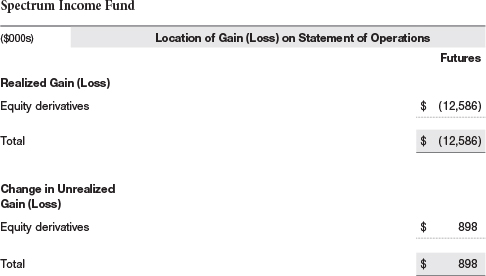
Futures Contracts A futures contract provides for the future sale by one party and purchase by another of a specified amount of a specific underlying financial instrument at an agreed upon price, date, time, and place. The funds currently invest only in exchange-traded futures, which generally are standardized as to maturity date, underlying financial instrument, and other contract terms. Payments are made or received by the fund each day to settle daily fluctuations in the value of the contract (variation margin), which reflect changes in the value of the underlying financial instrument. Variation margin is recorded as unrealized gain or loss until the contract is closed. The value of a futures contract included in net assets is the amount of unsettled variation margin; net variation margin receivable is reflected as an asset and net variation margin payable is reflected as a liability on the accompanying Statement of Assets and Liabilities. Risks related to the use of futures contracts include possible illiquidity of the futures markets, contract prices that can be highly volatile and imperfectly correlated to movements in hedged security values, and potential losses in excess of the fund’s initial investment. During the year ended December 31, 2021, the volume of the activity in futures, based on underlying notional amounts, was generally less than 1% for the Spectrum Income Fund.
NOTE 4 - INVESTMENTS IN UNDERLYING PRICE FUNDS
Purchases and sales of the underlying Price Funds during the year ended December 31, 2021, were as follows:
NOTE 5 - FEDERAL INCOME TAXES
Generally, no provision for federal income taxes is required since each fund intends to continue to qualify as a regulated investment company under Subchapter M of the Internal Revenue Code and distribute to shareholders all of its taxable income and gains. Distributions determined in accordance with federal income tax regulations may differ in amount or character from net investment income and realized gains for financial reporting purposes.
Each fund files U.S. federal, state, and local tax returns as required. Each fund’s tax returns are subject to examination by the relevant tax authorities until expiration of the applicable statute of limitations, which is generally three years after the filing of the tax return but which can be extended to six years in certain circumstances. Tax returns for open years have incorporated no uncertain tax positions that require a provision for income taxes.
Financial reporting records are adjusted for permanent book/tax differences to reflect tax character but are not adjusted for temporary differences. The permanent book/tax adjustments have no impact on results of operations or net assets and relate primarily to the character of distributions from the underlying funds.
Distributions during the year ended December 31, 2021, were characterized for tax purposes as follows:

Distributions during the prior year ended December 31, 2020, were characterized for tax purposes as follows:
At December 31, 2021, the tax-basis costs of investments and components of net assets were as follows:
The difference between book-basis and tax-basis net unrealized appreciation (depreciation) is attributable to the deferral of losses from wash sales for tax purposes. Each fund intends to retain realized gains to the extent of available capital loss carryforwards. Net realized capital losses may be carried forward indefinitely to offset future realized capital gains. All or a portion of a fund's capital loss carryforwards may be from losses realized between November 1 and the fund's year-end, which are deferred for tax purposes until the subsequent year but recognized for financial reporting purposes in the year realized.
NOTE 6 - RELATED PARTY TRANSACTIONS
The Spectrum Funds are managed by T. Rowe Price Associates, Inc. (Price Associates), a wholly owned subsidiary of T. Rowe Price Group, Inc. Price Associates, directly or through sub-advisory agreements with its wholly owned subsidiaries, also provides investment management services to all the underlying Price Funds. Pursuant to various service agreements, Price Associates and its wholly owned subsidiaries provide shareholder servicing and administrative services as well as certain accounting, marketing, and other services to the Spectrum Funds. Certain officers and directors of the Spectrum Funds are also officers and directors of Price Associates and its subsidiaries and of the underlying Price Funds.
Each fund operates in accordance with an amended investment management agreement (amended management agreement), between the corporation, on behalf of the funds, and Price Associates. Under the amended agreement, the Spectrum Diversified Equity Fund pays a fee rate of 0.73% for the Investor Class and 0.58% for the I Class; the Spectrum Income Fund pays a fee rate of 0.62% for the Investor Class and 0.47% for the I Class; and the Spectrum International Equity Fund pays a fee rate of 0.89% for the Investor Class and 0.74% for the I Class, respectively. The all-inclusive management fee covers investment management and all of each fund’s operating expenses except for interest expense; expenses related to borrowings, taxes, and brokerage; and any nonrecurring expenses.
Effective March 24, 2021, the date that each fund began charging, an all-inclusive management fee, the funds also converted from each underlying Price Fund’s Investor Class to its Z Class. Price Associates is contractually obligated to waive and/or bear all of the Z Class’ expenses, other than interest; expenses related to borrowings, taxes, and brokerage; and nonrecurring expenses. Prior to March 24, 2021, the funds paid no management fees; however, Price Associates received management fees from the underlying Price Funds. The funds operated in accordance with investment management and special servicing agreements between and among the corporation; the underlying Price Funds; Price Associates; and T. Rowe Price Services, Inc., a wholly owned subsidiary of Price Associates. Pursuant to these agreements, expenses associated with the operation of the funds were borne by each underlying Price Fund to the extent of estimated savings to it and in proportion to the average daily value of its shares owned by the funds. Each fund also indirectly bore its proportionate share of the management fees and operating costs of the underlying Price Funds in which it invested. The special servicing agreement terminated on March 23, 2021.
The Spectrum Funds do not invest in the underlying Price Funds for the purpose of exercising management or control; however, investments by the Spectrum Funds may represent a significant portion of an underlying Price Fund’s net assets. At December 31, 2021, Spectrum Diversified Equity Fund held less than 25% of the outstanding shares of any other underlying Price Fund; Spectrum Income Fund held approximately 61% of the outstanding shares of the Emerging Markets Local Currency Bond Fund, 47% of the GNMA Fund, 45% of the Corporate Income Fund, 30% of the International Bond Fund, and less than 25% of any other underlying Price Fund; Spectrum International Equity Fund held approximately 26% of the outstanding shares of the European Stock Fund and less than 25% of any other underlying Price Fund.
Each fund may invest in the T. Rowe Price Transition Fund (Transition Fund) to facilitate the fund’s transition between the various underlying Price Funds as the fund rebalances its allocation to the underlying Price Funds.
Additionally, Spectrum Income Fund is one of several mutual funds in which certain college savings plans managed by Price Associates may invest. Shareholder servicing costs associated with each college savings plan are allocated to Spectrum Income Fund in proportion to the average daily value of its shares owned by the college savings plan and, prior to March 24, 2021, were borne by the underlying Price Funds in accordance with the terms of the investment management and special servicing agreements. Effective March 24, 2021, shareholder servicing costs allocated to the fund are borne by Price Associates, pursuant to the fund’s all-inclusive fee agreement. At December 31, 2021, approximately 18% and 88% of the outstanding shares of the Investor Class and I Class, respectively, were held by the college savings plans.
NOTE 7 - OTHER MATTERS
Unpredictable events such as environmental or natural disasters, war, terrorism, pandemics, outbreaks of infectious diseases, and similar public health threats may significantly affect the economy and the markets and issuers in which a fund invests. Certain events may cause instability across global markets, including reduced liquidity and disruptions in trading markets, while some events may affect certain geographic regions, countries, sectors, and industries more significantly than others, and exacerbate other pre-existing political, social, and economic risks. The fund’s performance could be negatively impacted if the value of a portfolio holding were harmed by such events. Since 2020, a novel strain of coronavirus (COVID-19) has resulted in disruptions to global business activity and caused significant volatility and declines in global financial markets. The duration of this outbreak or others and their effects cannot be determined with certainty.
REPORT OF INDEPENDENT REGISTERED PUBLIC ACCOUNTING FIRM
To the Board of Directors of T. Rowe Price Spectrum Fund, Inc. and Shareholders
of T. Rowe Price Spectrum Diversified Equity Fund, T. Rowe Price Spectrum
Income Fund, and T. Rowe Price Spectrum International Equity Fund
Opinion on the Financial Statements
We have audited the accompanying statement of assets and liabilities, including the portfolio of investments, of T. Rowe Price Spectrum Diversified Equity Fund, T. Rowe Price Spectrum Income Fund, and T. Rowe Price Spectrum International Equity Fund (constituting T. Rowe Price Spectrum Fund, Inc., hereafter collectively referred to as the “Funds”) as of December 31, 2021, the related statement of operations for the year ended December 31, 2021, the statement of changes in net assets for each of the two years in the period ended December 31, 2021, including the related notes, and the financial highlights for each of the periods indicated therein (collectively referred to as the “financial statements”). In our opinion, the financial statements present fairly, in all material respects, the financial position of each of the Funds as of December 31, 2021, the results of each of their operations for the year then ended, the changes in each of their net assets for each of the two years in the period ended December 31, 2021 and each of the financial highlights for each of the periods indicated therein, in conformity with accounting principles generally accepted in the United States of America.
Basis for Opinion
These financial statements are the responsibility of the Funds’ management. Our responsibility is to express an opinion on the Funds’ financial statements based on our audits. We are a public accounting firm registered with the Public Company Accounting Oversight Board (United States) (PCAOB) and are required to be independent with respect to the Funds in accordance with the U.S. federal securities laws and the applicable rules and regulations of the Securities and Exchange Commission and the PCAOB.
We conducted our audits of these financial statements in accordance with the standards of the PCAOB. Those standards require that we plan and perform the audit to obtain reasonable assurance about whether the financial statements are free of material misstatement, whether due to error or fraud.
Our audits included performing procedures to assess the risks of material misstatement of the financial statements, whether due to error or fraud, and performing procedures that respond to those risks. Such procedures included examining, on a test basis, evidence regarding the amounts and disclosures in the financial statements. Our audits also included evaluating the accounting principles used and significant estimates made by management, as well as evaluating the overall presentation of the financial statements. Our procedures included confirmation of securities owned as of December 31, 2021 by correspondence with the transfer agent. We believe that our audits provide a reasonable basis for our opinion.
PricewaterhouseCoopers LLP
Baltimore, Maryland
February 15, 2022
We have served as the auditor of one or more investment companies in the T. Rowe Price group of investment companies since 1973.
TAX INFORMATION (UNAUDITED) FOR THE TAX YEAR ENDED 12/31/21
We are providing this information as required by the Internal Revenue Code. The amounts shown may differ from those elsewhere in this report because of differences between tax and financial reporting requirements.
The funds' distributions to shareholders included amounts as follows:
For taxable non-corporate shareholders, income represents qualified dividend income subject to a long-term capital gains tax rate of not greater than 20% as follows:
For corporate shareholders, income qualifies for the dividends-received deduction as follows:
The funds will pass through foreign source income and foreign taxes paid, as follows:
For individuals and certain trusts and estates which are entitled to claim a deduction of up to 20% of their combined qualified real estate investment trust (REIT) dividends, $638,000 of Spectrum Diversified Equity's income qualifies as qualified real estate investment trust (REIT) dividends.
INFORMATION ON PROXY VOTING POLICIES, PROCEDURES, AND RECORDS
A description of the policies and procedures used by T. Rowe Price funds to determine how to vote proxies relating to portfolio securities is available in each fund’s Statement of Additional Information. You may request this document by calling 1-800-225-5132 or by accessing the SEC’s website, sec.gov.
The description of our proxy voting policies and procedures is also available on our corporate website. To access it, please visit the following Web page:
https://www.troweprice.com/corporate/en/utility/policies.html
Scroll down to the section near the bottom of the page that says, “Proxy Voting Policies.” Click on the Proxy Voting Policies link in the shaded box.
Each fund’s most recent annual proxy voting record is available on our website and through the SEC’s website. To access it through T. Rowe Price, visit the website location shown above, and scroll down to the section near the bottom of the page that says, “Proxy Voting Records.” Click on the Proxy Voting Records link in the shaded box.
HOW TO OBTAIN QUARTERLY PORTFOLIO HOLDINGS
The fund files a complete schedule of portfolio holdings with the Securities and Exchange Commission (SEC) for the first and third quarters of each fiscal year as an exhibit to its reports on Form N-PORT. The fund’s reports on Form N-PORT are available electronically on the SEC’s website (sec.gov). In addition, most T. Rowe Price funds disclose their first and third fiscal quarter-end holdings on troweprice.com.
LIQUIDITY RISK MANAGEMENT PROGRAM
In accordance with Rule 22e-4 (Liquidity Rule) under the Investment Company Act of 1940, as amended, the fund has established a liquidity risk management program (Liquidity Program) reasonably designed to assess and manage the fund’s liquidity risk, which generally represents the risk that the fund would not be able to meet redemption requests without significant dilution of remaining investors’ interests in the fund. The fund’s Board of Directors (Board) has appointed the fund’s investment advisor, T. Rowe Price Associates, Inc. (Price Associates), as the administrator of the Liquidity Program. As administrator, Price Associates is responsible for overseeing the day-to-day operations of the Liquidity Program and, among other things, is responsible for assessing, managing, and reviewing with the Board at least annually the liquidity risk of each T. Rowe Price fund. Price Associates has delegated oversight of the Liquidity Program to a Liquidity Risk Committee (LRC), which is a cross-functional committee composed of personnel from multiple departments within Price Associates.
The Liquidity Program’s principal objectives include supporting the T. Rowe Price funds’ compliance with limits on investments in illiquid assets and mitigating the risk that the fund will be unable to timely meet its redemption obligations. The Liquidity Program also includes a number of elements that support the management and assessment of liquidity risk, including an annual assessment of factors that influence the fund’s liquidity and the periodic classification and reclassification of a fund’s investments into categories that reflect the LRC’s assessment of their relative liquidity under current market conditions. Under the Liquidity Program, every investment held by the fund is classified at least monthly into one of four liquidity categories based on estimations of the investment’s ability to be sold during designated time frames in current market conditions without significantly changing the investment’s market value.
As required by the Liquidity Rule, at a meeting held on July 27, 2021, the Board was presented with an annual assessment prepared by the LRC, on behalf of Price Associates, that addressed the operation of the Liquidity Program and assessed its adequacy and effectiveness of implementation, including any material changes to the Liquidity Program and the determination of each fund’s Highly Liquid Investment Minimum (HLIM). The annual assessment included consideration of the following factors, as applicable: the fund’s investment strategy and liquidity of portfolio investments during normal and reasonably foreseeable stressed conditions, including whether the investment strategy is appropriate for an open-end fund, the extent to which the strategy involves a relatively concentrated portfolio or large positions in particular issuers, and the use of borrowings for investment purposes and derivatives; short-term and long-term cash flow projections covering both normal and reasonably foreseeable stressed conditions; and holdings of cash and cash equivalents, as well as available borrowing arrangements.
For the fund and other T. Rowe Price funds, the annual assessment incorporated a report related to a fund’s holdings, shareholder and portfolio concentration, any borrowings during the period, cash flow projections, and other relevant data for the period of April 1, 2020, through March 31, 2021. The report described the methodology for classifying a fund’s investments (including derivative transactions) into one of four liquidity categories, as well as the percentage of a fund’s investments assigned to each category. It also explained the methodology for establishing a fund’s HLIM and noted that the LRC reviews the HLIM assigned to each fund no less frequently than annually.
During the period covered by the annual assessment, the LRC has concluded, and reported to the Board, that the Liquidity Program continues to operate adequately and effectively and is reasonably designed to assess and manage the fund’s liquidity risk.
ABOUT THE FUND’S DIRECTORS AND OFFICERS
Your fund is overseen by a Board of Directors (Board) that meets regularly to review a wide variety of matters affecting or potentially affecting the fund, including performance, investment programs, compliance matters, advisory fees and expenses, service providers, and business and regulatory affairs. The Board elects the fund’s officers, who are listed in the final table. At least 75% of the Board’s members are considered to be independent, i.e., not “interested persons” as defined in Section 2(a)(19) of the 1940 Act, of the Boards of T. Rowe Price Associates, Inc. (T. Rowe Price), and its affiliates; “interested” directors and officers are employees of T. Rowe Price. The business address of each director and officer is 100 East Pratt Street, Baltimore, Maryland 21202. The Statement of Additional Information includes additional information about the fund directors and is available without charge by calling a T. Rowe Price representative at 1-800-638-5660.
INDEPENDENT DIRECTORS(a)
Name
(Year of Birth)
Year Elected
[Number of T. Rowe Price
Portfolios Overseen] | | Principal Occupation(s) and Directorships of Public Companies and
Other Investment Companies During the Past Five Years |
| | | |
Teresa Bryce Bazemore
(1959)
2018
[204] | | President and Chief Executive Officer, Federal Home Loan Bank of San Francisco (2021 to present); President, Radian Guaranty (2008 to 2017); Chief Executive Officer, Bazemore Consulting LLC (2018 to 2021); Director, Chimera Investment Corporation (2017 to 2021); Director, First Industrial Realty Trust (2020 to present); Director, Federal Home Loan Bank of Pittsburgh (2017 to 2019) |
| | | |
Ronald J. Daniels
(1959)
2018
[204] | | President, The Johns Hopkins University(b) and Professor, Political Science Department, The Johns Hopkins University (2009 to present); Director, Lyndhurst Holdings (2015 to present); Director, BridgeBio Pharma, Inc. (2020 to present) |
| | | |
Bruce W. Duncan
(1951)
2013
[204] | | President, Chief Executive Officer, and Director, CyrusOne, Inc. (2020 to 2021); Chief Executive Officer and Director (2009 to 2016), Chair of the Board (2016 to 2020), and President (2009 to 2016), First Industrial Realty Trust, owner and operator of industrial properties; Chair of the Board (2005 to 2016) and Director (1999 to 2016), Starwood Hotels & Resorts, a hotel and leisure company; Member, Investment Company Institute Board of Governors (2017 to 2019); Member, Independent Directors Council Governing Board (2017 to 2019); Senior Advisor, KKR (2018 to present); Director, Boston Properties (2016 to present); Director, Marriott International, Inc. (2016 to 2020) |
| | | |
Robert J. Gerrard, Jr.
(1952)
2012
[204] | | Advisory Board Member, Pipeline Crisis/Winning Strategies, a collaborative working to improve opportunities for young African Americans (1997 to 2016); Chair of the Board, all funds (July 2018 to present) |
| | | |
Paul F. McBride
(1956)
2013
[204] | | Advisory Board Member, Vizzia Technologies (2015 to present); Board Member, Dunbar Armored (2012 to 2018) |
| | | |
Cecilia E. Rouse, Ph.D.(c)
(1963)
2012
[0] | | Dean, Princeton School of Public and International Affairs (2012 to present); Professor and Researcher, Princeton University (1992 to present); Director of Education Studies Committee, MDRC, a nonprofit education and social policy research organization (2011 to 2020); Member, National Academy of Education (2010 to present); Board Member, National Bureau of Economic Research (2011 to present); Board Member of the Council on Foreign Relations (2018 to present); Board Member, The Pennington School (2017 to present); Board Member, the University of Rhode Island (2020 to present); Chair of Committee on the Status of Minority Groups in the Economic Profession of the American Economic Association (2012 to 2018); Vice President (2015 to 2016) and Board Member (2018 to present), American Economic Association |
| | | |
John G. Schreiber(d)
(1946)
2001
[0] | | Owner/President, Centaur Capital Partners, Inc., a real estate investment company (1991 to present); Cofounder, Partner, and Cochair of the Investment Committee, Blackstone Real Estate Advisors, L.P. (1992 to 2015); Director, Blackstone Mortgage Trust, a real estate finance company (2012 to 2016); Director and Chair of the Board, Brixmor Property Group, Inc. (2013 to present); Director, Hilton Worldwide (2007 to present); Director, Hudson Pacific Properties (2014 to 2016); Director, Invitation Homes (2014 to 2017); Director, JMB Realty Corporation (1980 to present) |
| | | |
Kellye Walker(e)
(1966)
2021
[204] | | Executive Vice President and Chief Legal Officer, Eastman Chemical Company (April 2020 to present); Executive Vice President and Chief Legal Officer, Huntington Ingalls Industries, Inc. (NYSE: HIl) (January 2015 to March 2020); Director, Lincoln Electric Company (October 2020 to present) |
| | | |
| (a) All information about the independent directors was current as of December 31, 2020, unless otherwise indicated, except for the number of portfolios overseen, which is current as of the date of this report. |
| (b) William J. Stromberg, chair of the Board, director, and chief executive officer of T. Rowe Price Group, Inc., the parent company of the Price Funds’ investment advisor, has served on the Board of Trustees of Johns Hopkins University since 2014. |
| (c) Effective March 4, 2021, Dr. Rouse resigned from her role as independent director of the Price Funds. |
| (d) Effective December 31, 2021, Mr. Schreiber resigned from his role as independent director of the Price Funds. |
| (e) Effective November 8, 2021, Ms. Walker was elected as independent director of the Price Funds. |
INTERESTED DIRECTORS(a)
Name
(Year of Birth)
Year Elected
[Number of T. Rowe Price
Portfolios Overseen] | | Principal Occupation(s) and Directorships of Public Companies and
Other Investment Companies During the Past Five Years |
| | | |
David Oestreicher
(1967)
2018
[204] | | General Counsel, Vice President, and Secretary, T. Rowe Price Group, Inc.; Chair of the Board, Chief Executive Officer, President, and Secretary, T. Rowe Price Trust Company; Director, Vice President, and Secretary, T. Rowe Price, T. Rowe Price Investment Services, Inc., T. Rowe Price Retirement Plan Services, Inc., and T. Rowe Price Services, Inc.; Director and Secretary, T. Rowe Price Investment Management, Inc. (Price Investment Management); Vice President and Secretary, T. Rowe Price International (Price International); Vice President, T. Rowe Price Hong Kong (Price Hong Kong), T. Rowe Price Japan (Price Japan), and T. Rowe Price Singapore (Price Singapore); Principal Executive Officer and Executive Vice President, all funds |
| | | |
Robert W. Sharps, CFA, CPA
(1971)
2017
[204] | | Director and Vice President, T. Rowe Price; President, T. Rowe Price Group, Inc.; Director, Price Investment Management; Vice President, T. Rowe Price Trust Company; Vice President, Spectrum Funds |
| | | |
| (a) All information about the interested directors was current as of December 31, 2020, unless otherwise indicated, except for the number of portfolios overseen, which is current as of the date of this report. |
OFFICERS
Name (Year of Birth)
Position Held With Spectrum Funds | | Principal Occupation(s) |
| | | |
Francisco M. Alonso (1978)
Vice President | | Vice President, T. Rowe Price, T. Rowe Price Group, Inc., and T. Rowe Price Trust Company |
| | | |
Stephen L. Bartolini, CFA (1977)
Vice President | | Vice President, T. Rowe Price, T. Rowe Price Group, Inc., and T. Rowe Price Trust Company |
| | | |
Kimberly E. DeDominicis (1976)
Vice President | | Vice President, T. Rowe Price, T. Rowe Price Group, Inc., Price International, and T. Rowe Price Trust Company |
| | | |
Alan S. Dupski, CPA (1982)
Principal Financial Officer, Vice President,
and Treasurer | | Vice President, T. Rowe Price, T. Rowe Price Group, Inc., and T. Rowe Price Trust Company |
| | | |
David J. Eiswert, CFA (1972)
Vice President | | Vice President, T. Rowe Price and T. Rowe Price Group, Inc. |
| | | |
Mark S. Finn, CFA, CPA (1963)
Vice President | | Vice President, T. Rowe Price, T. Rowe Price Group, Inc., and T. Rowe Price Trust Company |
| | | |
John R. Gilner (1961)
Chief Compliance Officer | | Chief Compliance Officer and Vice President, T. Rowe Price; Vice President, T. Rowe Price Group, Inc., and T. Rowe Price Investment Services, Inc. |
| | | |
David R. Giroux, CFA (1975)
Vice President | | Vice President, Price Investment Management, T. Rowe Price, T. Rowe Price Group, Inc., and T. Rowe Price Trust Company |
| | | |
Gary J. Greb (1961)
Vice President | | Vice President, T. Rowe Price, Price International, and T. Rowe Price Trust Company |
| | | |
Arif Husain, CFA (1972)
Vice President | | Vice President, T. Rowe Price Group, Inc., and Price International |
| | | |
Paul J. Krug, CPA (1964)
Vice President | | Vice President, T. Rowe Price, T. Rowe Price Group, Inc., and T. Rowe Price Trust Company |
| | | |
Wyatt A. Lee, CFA (1971)
Vice President | | Vice President, T. Rowe Price, T. Rowe Price Group, Inc., and T. Rowe Price Trust Company |
| | | |
Sébastien Page (1977)
Vice President | | Vice President, T. Rowe Price and T. Rowe Price Group, Inc. |
| | | |
Robert A. Panariello (1983)
Vice President | | Vice President, T. Rowe Price and T. Rowe Price Group, Inc. |
| | | |
Fran M. Pollack-Matz (1961)
Vice President and Secretary | | Vice President, T. Rowe Price, T. Rowe Price Group, Inc., T. Rowe Price Investment Services, Inc., and T. Rowe Price Services, Inc. |
| | | |
Shannon H. Rauser (1987)
Assistant Secretary | | Assistant Vice President, T. Rowe Price |
| | | |
Charles M. Shriver, CFA (1967)
Co-president | | Vice President, T. Rowe Price, T. Rowe Price Group, Inc., Price International, and T. Rowe Price Trust Company |
| | | |
Guido F. Stubenrauch, CFA (1970)
Vice President | | Vice President, T. Rowe Price and T. Rowe Price Group, Inc. |
| | | |
Toby M. Thompson, CAIA, CFA (1971)
Co-president | | Vice President, T. Rowe Price, T. Rowe Price Group, Inc., Price International, and T. Rowe Price Trust Company |
| | | |
Justin Thomson (1968)
Vice President | | Director, Price Hong Kong; Vice President, T. Rowe Price Group, Inc.; Director and Vice President, Price International |
| | | |
Megan Warren (1968)
Vice President | | Vice President, T. Rowe Price, T. Rowe Price Group, Inc., T. Rowe Price Retirement Plan Services, Inc., T. Rowe Price Services, Inc., and T. Rowe Price Trust Company; formerly, Executive Director, JPMorgan Chase (to 2017) |
Unless otherwise noted, officers have been employees of T. Rowe Price or Price International for at least 5 years.
Item 1. (b) Notice pursuant to Rule 30e-3.
Not applicable.
Item 2. Code of Ethics.
The registrant has adopted a code of ethics, as defined in Item 2 of Form N-CSR, applicable to its principal executive officer, principal financial officer, principal accounting officer or controller, or persons performing similar functions. A copy of this code of ethics is filed as an exhibit to this Form N-CSR. No substantive amendments were approved or waivers were granted to this code of ethics during the period covered by this report.
Item 3. Audit Committee Financial Expert.
The registrant's Board of Directors has determined that Ms. Teresa Bryce Bazemore qualifies as an audit committee financial expert, as defined in Item 3 of Form N-CSR. Ms. Bazemore is considered independent for purposes of Item 3 of Form N-CSR.
Item 4. Principal Accountant Fees and Services.
(a) – (d) Aggregate fees billed for the last two fiscal years for professional services rendered to, or on behalf of, the registrant by the registrant's principal accountant were as follows:

Audit fees include amounts related to the audit of the registrant's annual financial statements and services normally provided by the accountant in connection with statutory and regulatory filings. Audit-related fees include amounts reasonably related to the performance of the audit of the registrant's financial statements and specifically include the issuance of a report on internal controls and, if applicable, agreed-upon procedures related to fund acquisitions. Tax fees include amounts related to services for tax compliance, tax planning, and tax advice. The nature of these services specifically includes the review of distribution calculations and the preparation of Federal, state, and excise tax returns. All other fees include the registrant's pro-rata share of amounts for agreed-upon procedures in conjunction with service contract approvals by the registrant's Board of Directors/Trustees.
(e)(1) The registrant's audit committee has adopted a policy whereby audit and non-audit services performed by the registrant's principal accountant for the registrant, its investment adviser, and any entity controlling, controlled by, or under common control with the investment adviser that provides ongoing services to the registrant require pre-approval in advance at regularly scheduled audit committee meetings. If such a service is required between regularly scheduled audit committee meetings, pre-approval may be authorized by one audit committee member with ratification at the next scheduled audit committee meeting. Waiver of pre-approval for audit or non-audit services requiring fees of a de minimis amount is not permitted.
(2) No services included in (b) – (d) above were approved pursuant to paragraph (c)(7)(i)(C) of Rule 2-01 of Regulation S-X.
(f) Less than 50 percent of the hours expended on the principal accountant's engagement to audit the registrant's financial statements for the most recent fiscal year were attributed to work performed by persons other than the principal accountant's full-time, permanent employees.
(g) The aggregate fees billed for the most recent fiscal year and the preceding fiscal year by the registrant’s principal accountant for non-audit services rendered to the registrant, its investment adviser, and any entity controlling, controlled by, or under common control with the investment adviser that provides ongoing services to the registrant were $3,732,000 and $3,781,000, respectively.
(h) All non-audit services rendered in (g) above were pre-approved by the registrant’s audit committee. Accordingly, these services were considered by the registrant’s audit committee in maintaining the principal accountant’s independence.
Item 5. Audit Committee of Listed Registrants.
Not applicable.
Item 6. Investments.
(a) Not applicable. The complete schedule of investments is included in Item 1 of this Form N-CSR.
(b) Not applicable.
Item 7. Disclosure of Proxy Voting Policies and Procedures for Closed-End Management Investment Companies.
Not applicable.
Item 8. Portfolio Managers of Closed-End Management Investment Companies.
Not applicable.
Item 9. Purchases of Equity Securities by Closed-End Management Investment Company and Affiliated Purchasers.
Not applicable.
Item 10. Submission of Matters to a Vote of Security Holders.
There has been no change to the procedures by which shareholders may recommend nominees to the registrant’s board of directors.
Item 11. Controls and Procedures.
(a) The registrant’s principal executive officer and principal financial officer have evaluated the registrant’s disclosure controls and procedures within 90 days of this filing and have concluded that the registrant’s disclosure controls and procedures were effective, as of that date, in ensuring that information required to be disclosed by the registrant in this Form N-CSR was recorded, processed, summarized, and reported timely.
(b) The registrant’s principal executive officer and principal financial officer are aware of no change in the registrant’s internal control over financial reporting that occurred during the period covered by this report that has materially affected, or is reasonably likely to materially affect, the registrant’s internal control over financial reporting.
Item 12. Disclosure of Securities Lending Activities for Closed-End Management Investment Companies.
Not applicable.
Item 13. Exhibits.
(a)(1) The registrant's code of ethics pursuant to Item 2 of Form N-CSR is attached.
(2) Separate certifications by the registrant's principal executive officer and principal financial officer, pursuant to Section 302 of the Sarbanes-Oxley Act of 2002 and required by Rule 30a-2(a) under the Investment Company Act of 1940, are attached.
(3) Written solicitation to repurchase securities issued by closed-end companies: not applicable.
(b) A certification by the registrant's principal executive officer and principal financial officer, pursuant to Section 906 of the Sarbanes-Oxley Act of 2002 and required by Rule 30a-2(b) under the Investment Company Act of 1940, is attached.
SIGNATURES
Pursuant to the requirements of the Securities Exchange Act of 1934 and the Investment Company Act of 1940, the registrant has duly caused this report to be signed on its behalf by the undersigned, thereunto duly authorized.
T. Rowe Price Spectrum Fund, Inc.
| By | | /s/ David Oestreicher |
| | | David Oestreicher |
| | | Principal Executive Officer |
| | | | |
| |
| Date | | February 15, 2022 | | | | |
| | | | | | | |
Pursuant to the requirements of the Securities Exchange Act of 1934 and the Investment Company Act of 1940, this report has been signed below by the following persons on behalf of the registrant and in the capacities and on the dates indicated.
| By | | /s/ David Oestreicher |
| | | David Oestreicher |
| | | Principal Executive Officer |
| | | | |
| |
| Date | | February 15, 2022 | | | | |
| | | | | | | |
| By | | /s/ Alan S. Dupski |
| | | Alan S. Dupski |
| | | Principal Financial Officer |
| | | | |
| |
| Date | | February 15, 2022 | | | | |



